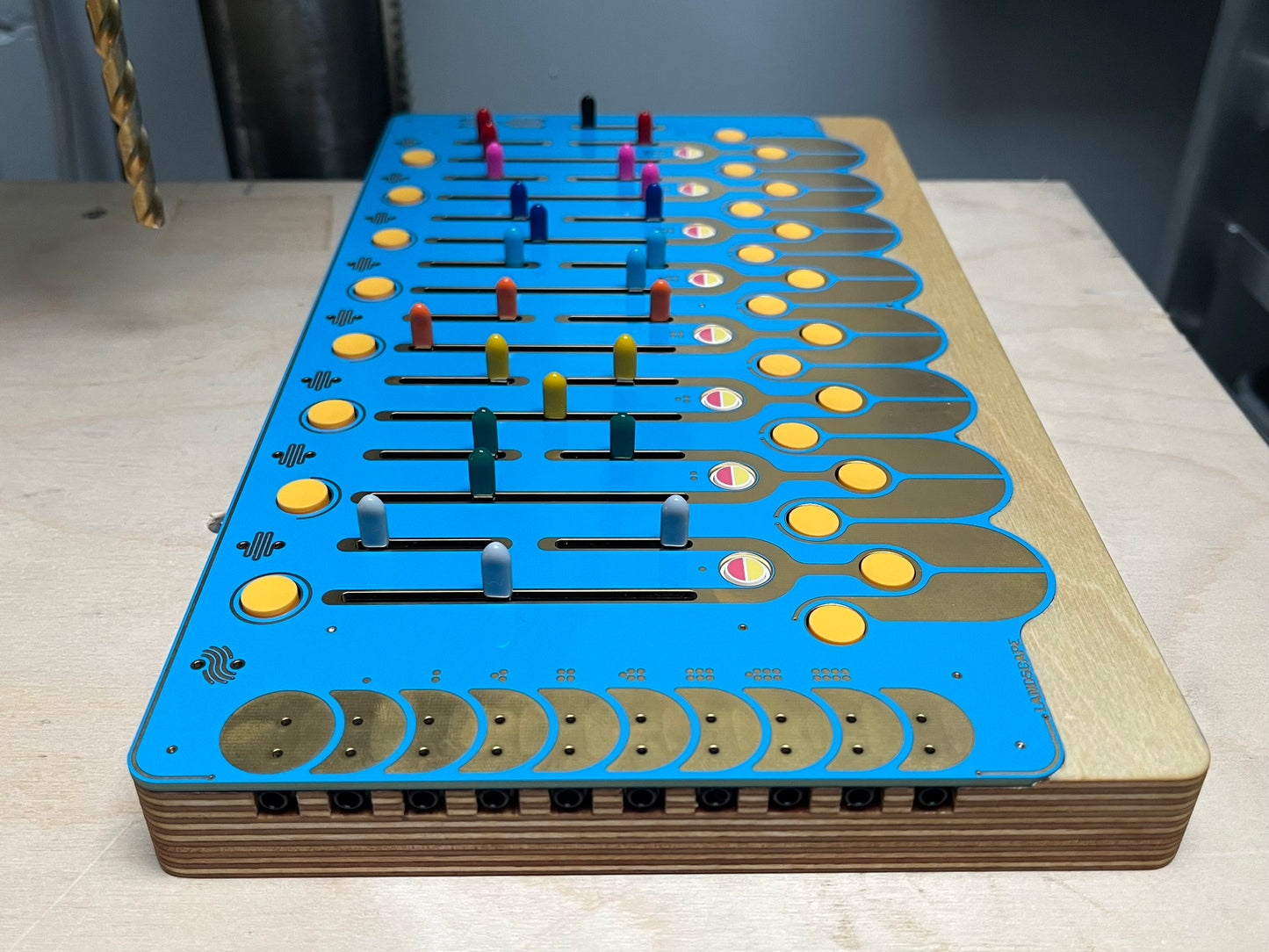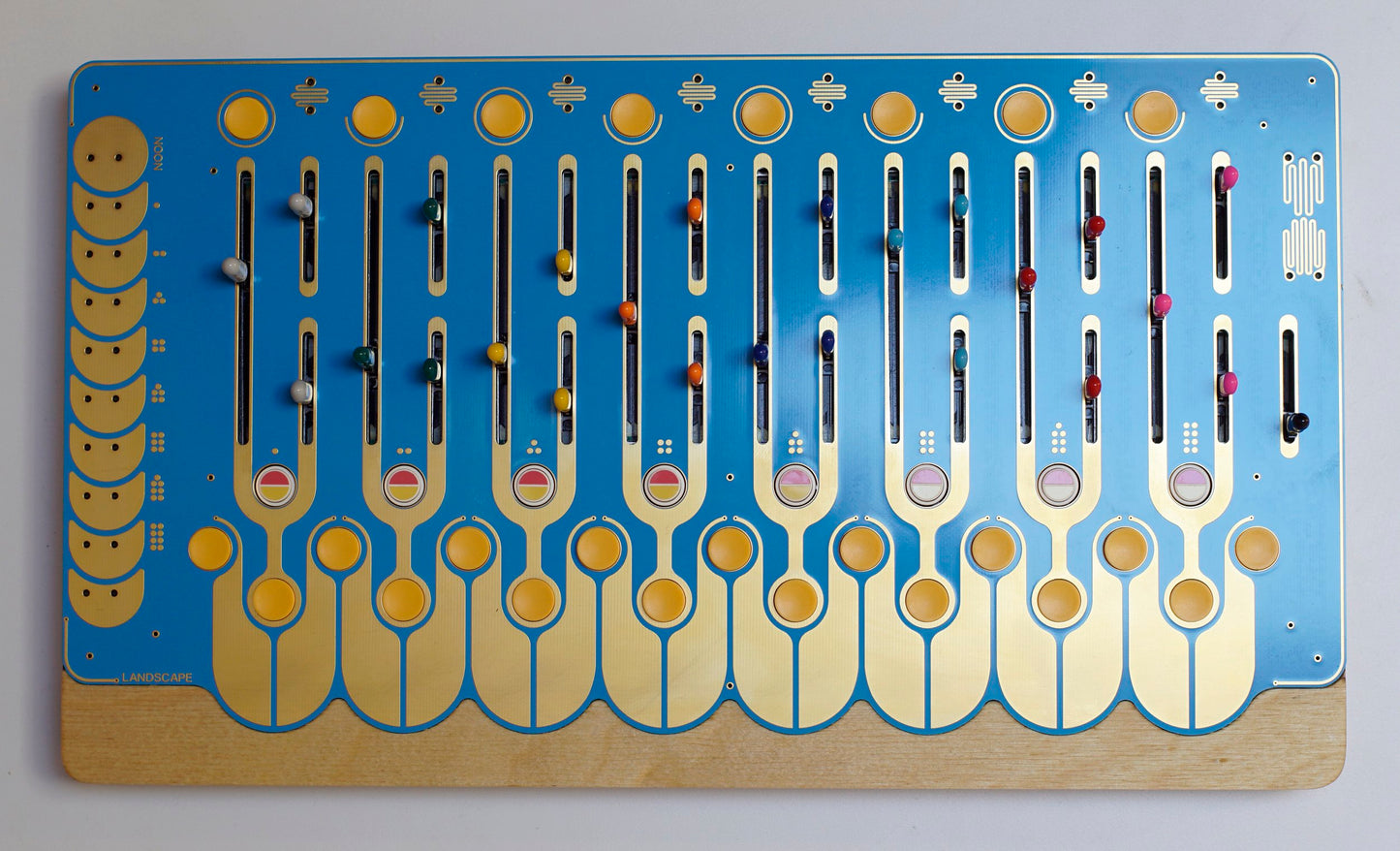Landscape
Noon
Noon
Couldn't load pickup availability
Overview✺
-
WHO❀ Noon
-
WHAT❈ An 8 channel powerless instrument which is activated and modulated using voltage from external sequencers.
-
HOW✷ Analog circuits are powered momentarily by incoming gate and control voltage signals causing them to oscillate and breathe naturally. When these circuits are linked together they can grow, inform and process one another in complex rhythmic ways.
-
WHY❃ This technique increases the unstable properties of analog circuits, causing increased organic textures and movement. The simple controls are provided to ensure immediacy and access to rapidly alter sounds and movement without patching.
-
WHERE✾ The simplicity of the interface was designed with live performance in mind. The number of internal and external variables (control voltage types, linked channel behavior plus external audio input) create lots of room for studio exploration.
-
WHEN✻ Now
IN-DEPTH✹
NOON is a passive analog drum/synthesizer. Each of the eight channels uses a unique analog circuit with its own characteristics. No power supply is needed. Each circuit is triggered and powered individually from incoming gates or control voltages provided by voltage sequencers or modular systems. By using this unique method, we can increase instability and magnify organic aspects of traditional analog electronic instruments. The sound of analog, at its core, is the sound of sculpted electricity. By removing the stabilizing elements of a constant power source, we can listen to the sound of electronic circuits loading and unloading, powering up and powering down, and we can increase the natural chaotic movement of electricity. The loading of circuits creates natural ways to access swing and groove or ways to deconstruct a programmed rhythm sequence to make surprisingly new ideas.
Each channel is represented by a tuning fork. Incoming voltage can be thought of as a way to “strike” each fork with momentary voltage. Between every channel there are Link buttons which allow voltage sharing between channels. Linking them provides a wide mix of results depending on incoming voltage, active or inactive channels, slider settings, gate lengths and multichannel linking. The results can be described as cross modulation, growth (creating a larger and more complex circuit), or processing (filtering, distortion). Due to the cycles of voltage and this inherent instability, a definition of what is actually occurring between channels can be hard to pin down. The eight Mod buttons, which are located at the bottom of each tuning fork, change the behavior and sound of each circuit. The eight latching CV buttons along the top allow the “☾” Even and “❍” Odd CV modulation inputs to route to even and odd channels. When incoming CV is unmuted, a channel’s behavior can change drastically and this behavior can change further when channels are linked. These CV inputs are a way to add microtonal pitch changes and/or large textural movement to voices. The Even and Odd CV inputs are summed to their respective channels to provide a rhythmic modulation reference between multiple channels. ⏚
☁︎Which Sequencers/Control Voltage Sources Work
Each model of voltage sequencer will have different effects on the tonality of the instrument due to differences in power and feature sets between manufacturers. NOTE: The strongest recommendations for Noon are currently the Arturia Beatstep Pro and Eurorack modular systems. This is due to the strength of power provided and quick access to gate/control voltage variations. Noon has shown great results with these sequencers (and voltage source examples) thus far:
-Sequentix Cirklon / Arturia Beatstep Pro & Keystep Pro / ALM Busy Circuits Pamala’s Workout / Make Noise 0-ctrl / Westlicht Per Former / Qu-Bit Contour / Schlappi Engineering Angle Grinder / Music Thing Turing Machine + Pulses mkii / Polyend Poly 2 / Sixty Four Pixels CV.OCD / Social Entropy Engine / Making Sound Machines Stolperbeats / Soma Ornament-8 / Soma Pulsar-23 / Acid Rain Technology Constellation / Five12 Vector Sequencer / Mannequins Just Friends / Mutable Instruments Marbles & Stages / Expert Sleepers ES-9 & FH-2 / OXI One / monome teletype + meadowphysics / Meng Qi Voltage Memory / vpme.de Euclidean Circles v2 / ET Levit8 / MPC One / WMD Metron / Tiptop Audio Trigger Riot / Shakmat Four Bricks Rook / Frap Tools Falistri / Lorre Mill Double Knot / ⌘various audio rate oscillators
☂︎Which Sequencers/Control Voltage Sources Don’t.
Given the very close relationship between Noon and what’s driving it you could experience non-flattering results in some cases. We’ve mostly found that USB powered sequencers (*other than the BSP) provide less power. Please Note: two of these were listed in the working category previously but after some circuit changes and further testing we can’t recommend them without using an external MIDI to CV converter for additional power. Note II: you can still get some good sound out of them!
-Korg SQ-64 (low power, **However, we’ve been told that using a Volca power supply and updating to the newest firmware is a big help)
-Synthstrom Deluge (low power, can activate some voices but not all)
-Torso T-1 (low power, can activate some voices but not all)
*we continue to post more examples of working/non-working relationships as we get access to more equipment and learn of more accounts from users. Thank you for all the suggestions thus far!
Audio☁︎
-
The sound examples below were sequenced/powered using the Arturia Beatstep Pro, unless otherwise noted. Some examples use 12v, 10v and 5v gates.
-
No swing is used in the examples and all pattern examples are quantized.
-
No compression, limiting or effects are applied. Please use caution when listening at louder volumes.
-
The feedback and distortion heard in various examples is not due to a specially designed “distortion effect”, it is the organic results of multichannel linking and the character of the circuits.
-
Below you will find five groupings of multichannel focused examples and eight groupings of single channel focused examples ▼







